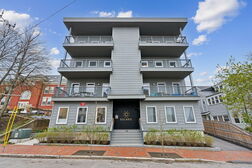Biz Bites: Portland's latest residential stats, Maliseet housing development on tap
 Courtesy / Meateater/Cal's Journal screen image
A screen image from the Meateater episode of "Cal's Journey" that features the Shiloh Pond project in Kingfield and Maine's land access issues.
Courtesy / Meateater/Cal's Journal screen image
A screen image from the Meateater episode of "Cal's Journey" that features the Shiloh Pond project in Kingfield and Maine's land access issues.
Anyone who isn't aware of the up up up price trend in Maine residential real estate over the past year is living in a (probabably very expensive) cave. And, in Portland, that's a trend on steroids.
The median price of a single-family home in Portland jumped from $460,000 in February to $514,500 in March, according to the monthly stats put out by Benchmark Real Estate. Those listing a home can expect it to spend a zippy six days on the market.
Multifamily Portland prices had a similar hike from February, with the median price of $667,500 is up from $612,500. Multifamilies spend about eight days on the market. The state median is $268,500.
The most interesting stats, though, are for condo sales. Median price, of course, follows the trend, with the March number at $512,500, up from $421,950. Because of some major developments opening up, including the 31-unit Verdane at Lincoln Park development at 99 Federal St., days on the market for condos has increased from 22 in March 2020 to 84 in March 2021. Sales volume was up from $8.8 million a year ago to $46.7 million this March.
That said, condominiums spent a median 44 days on the market in March. Tom Landry, of Benchmark, said days on the market aren't a good measure of the market, because condo developments initially launch with a concept and the units are on the market for months. That said, the pace is a little slower than single-family and multis because of changing buyer trends. "The trend over the last year has been away from larger buildings and into more suburban and rural environment," he said. "People seem to want to have more space, whether inside or outside."
That doesn't mean people aren't buying condos in Portland, and paying well for them, of course. The priciest overall residential sale in Portland in March was a condo — $1,269,250 at 99 Federal St., edging past the highest-priced single family home, which was $1,230,000 at 51 Deering St., in downtown Portland. The biggest mutlifamily sale was $1,561,250, at 5 Merrill St., on Munjoy Hill.
The lowest priced single-family sale was $275,000 at 21 Bryant St., in the Woodfords neighborhood. The lowest-priced condo was 105 Brackett St., in the neighborhood between State Street and the West End. The lowest-priced multifamily sold was for $459,000, at 9-11 Glenwood Ave., in the Highlands neighborhood adjacent to Woodfords.
SHILOH POND PROJECT SPURS ACCESS FEATURE. Shiloh Pond, in Kingfield, which was bought by the town and conserved through a group effort of associations, including Franklin County's High Peaks Alliance, and is now officially the Kingfield Community Forest, has continued to grab the attention of Montana-based outdoor lifestyle company Meateater Inc. Meater, founded by Steve Rinella, has TV shows, a podcats and more. You may remember that in August, Meater took on the Shilho Pond cause as the first project featured in its Land Access Initiative, which ended up raising $70,000. Now the company has featured the project, the High Peaks Alliance and Maine's land access issues an episode of the Meateater show "Cal's Journal." The episode, "Maiine - Private Ground & Public Woodcock & Grouse," is available to watch on YouTube.
SADDLEBACK AREA GAINING MOMENTUM. Elsewhere in Franklin county, there are some signs of development near, or related to the Saddleback Ski area reopening. Earlier this month, the Land Use Planning Commission, which oversees the unorganized terrority approved the 17-condo Niboban on Rangeley Lake project, which had first been proposed in 2014. Since then, the lakeside property, which began as a sporting camp in the 1880s, has changed hands, and the project was revived a couple years ago. It will add 17 condos to what's there, making 28.
In other recent developments, Arctaris Saddleback, which owns the ski resort, filed a commercial subdivision application with the LUPC on April 22. The commission oversees the four unorganized townships that the 6,200-acre ski area stretches over. Arctaris plans a variety of development projects aside from those strictly ski-related. Details to come.
MALISEET HOME PROJECT GETS BOOST. The Houlton Band of Maliseets has been awarded $68,000 from Four Directions Development Corp. to kick off a plan for affordable homes on tribal land in Aroostook County. The tribe, headquartered in Littleton, only offers rentals to members, and the plan will be a first step toward affordable home ownership. The grant will fund an engineering plan that will be the start of a two phase housing development that will eventually provide 15 homes, including two model homes that are being built this summer.
Tribal Chief Clarissa Sabattis said, "This project resulted from a homeownership needs assessment survey we conducted in partnership with FDDC that revealed a real interest in homeownership by our members. We are excited to be a recipient of this award that enables us to begin this project.”
WATERVILLE ARENA PROJECT KICKS OFF. Details of a new project by the Boys & Girls Clubs and YMCA at the Alfond Youth & Community Center in Waterville will be announced Friday. The space will include a fully enclosed arena that has five months of a full sheet of hockey ice and seven months of a turfed surface for sports.
The $4 million project was approved by the city council in September, and will be on the youth center's North Street campus. Friday's event will include AYCC CEO Ken Walsh, Arena Steering Committee Chair Paul Boudreau and founding doners from the project, including Doug and Rita Sukeforth, of the Sukeforth Family Foundation; David Greene, president of Colby Collge; David Roy, of Kennebec Savings Bank; Mitch Sammons, of Sheridan Corp.; Erik Nadeau and James Laliberte, of the Central Maine Youth Hockey Foundation, Ted Fabian, of Fabian Oil, of Oakland, and members of the Boullette family.
HOUSING VALUE GAPS HAVE LONG-TERM EFFECTS. A study just released by the National Assocation of Realtors founded that home-value gaps for Hispanic, Black American homebuyers buying their first house, as well as those who owe on student loans, lead to future wealth gaps. The study, by Jessica Lautz, of NAR, and Michael White, director of the Centre of the Built Environment, examines purchase price differences among U.S. home buyers from January 2014 to December 2017.
Hispanic and Black Americans bought homes 11.2% and 10.6% less expensive, respectively, than White American, and buyers who had student debt bought homes that were 18.8% less expensive than buyers who didn't have student debt. The study said that homeownership is one of the best ways to build wealth; buying homes that are significantly less expensive can lead to lost wealth accumulation – and possibly lost homeownership – across generations. Policy steps that may help close the gap suggested by the report include providing more financial literacy, refinancing student loans, expansion of mortgage financing though alternative credit scoring models and expanding public awareness of programs that help with down payments.














0 Comments